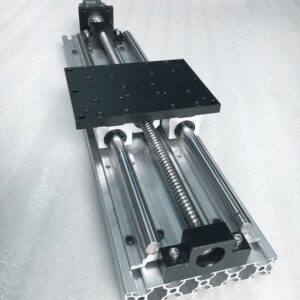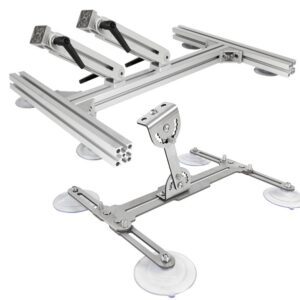Outline for Profile Rail
| Main Heading | Sub-Headings |
|---|---|
| Introduction to Profile Rail | Definition and purpose |
| The Role of Profile Rail in Precision Motion | Why industries rely on profile rails |
| Key Components of a Profile Rail System | Rails, blocks, rolling elements, seals |
| Working Principle of Profile Rail | How linear motion is achieved |
| Types of Profile Rail Systems | Ball-type, roller-type, miniature profile rails |
| Profile Rail vs Round Rail | Comparing accuracy and rigidity |
| Material Selection in Profile Rail Design | Stainless steel, carbon steel, composite options |
| Load Capacity and Rigidity in Profile Rail Systems | Static and dynamic loads |
| Accuracy and Repeatability of Profile Rail | Motion precision and stability |
| Applications of Profile Rail in CNC Machines | Milling, drilling, laser cutting |
| Profile Rail in Robotics and Automation | Smooth, precise robotic motion |
| Use of Profile Rail in Medical Devices | Imaging systems, diagnostic tools, surgical robots |
| Profile Rail in Packaging and Assembly Lines | Efficiency and high-speed reliability |
| Installation Guidelines for Profile Rail | Surface prep, alignment, torque settings |
| Lubrication and Maintenance of Profile Rail | Grease, oil, and self-lubricating systems |
| Common Challenges with Profile Rail Systems | Misalignment, contamination, lubrication issues |
| Environmental Factors Impacting Profile Rail | Dust, humidity, chemicals, temperature |
| Innovations in Profile Rail Technology | Smart sensors, coatings, lightweight designs |
| Profile Rail vs Linear Guideway Rail | Similarities and differences |
| High-Speed Applications of Profile Rail | Electronics, packaging, automated inspection |
| Sustainability in Profile Rail Manufacturing | Eco-friendly materials, energy efficiency |
| Cost Considerations for Profile Rail | Purchase price vs lifecycle costs |
| Choosing the Right Profile Rail for Your Application | Load, speed, accuracy, environment |
| Future of Profile Rail Systems | AI-driven motion control and smart factories |
| Profile Rail | Summary of its importance |
| Frequently Asked Questions | Six detailed FAQs |
| Conclusion | Final thoughts on profile rail |
Introduction to Profile Rail
A profile rail is a linear motion system designed to provide smooth, accurate, and reliable movement across a straight path. Unlike simple sliding rails, profile rails use rolling elements such as balls or rollers between the rail and the block, dramatically reducing friction while maintaining rigidity.
Profile rails are widely used in CNC machines, robotics, packaging equipment, and medical devices. Their compact design, high load capacity, and precision make them essential in industries where accuracy and efficiency are non-negotiable.
The Role of Profile Rail in Precision Motion
In modern engineering, precision is everything. Even the smallest deviation in motion can cause defects, wasted materials, and downtime. Profile rails ensure:
Stable, repeatable movement in industrial automation.
High rigidity for cutting, drilling, and machining operations.
Energy efficiency, since rolling elements reduce resistance.
Extended machine life, as reduced friction minimizes wear.
Industries rely on profile rails because they transform raw power into controlled, predictable motion.
Key Components of a Profile Rail System
A profile rail system is composed of several key parts that work together to achieve accuracy:
Rails: Precision-ground tracks that guide the carriage.
Blocks (carriages): Travel along the rail, carrying loads while maintaining rigidity.
Rolling elements: Balls or rollers that reduce friction between rail and block.
Seals and retainers: Protect against dust, dirt, and lubrication loss.
Every component must be precisely engineered to ensure the system performs reliably under heavy loads and demanding environments.
Working Principle of Profile Rail
The principle behind profile rails is simple yet effective:
Rolling elements circulate between the rail and block.
Instead of sliding friction, rolling friction dominates, reducing resistance by up to 90%.
The carriage maintains constant, smooth motion across the rail, even under heavy loads.
This design ensures that profile rails achieve both high speed and micron-level accuracy, making them indispensable in high-performance industries.
Types of Profile Rail Systems
Profile rails come in different types depending on the application:
Ball-type profile rails: Smooth and quiet, designed for fast and precise movements. Best for light to medium loads.
Roller-type profile rails: Provide higher rigidity and load-bearing capacity, suitable for heavy-duty machining.
Miniature profile rails: Compact and precise, used in medical devices, electronics, and optical systems.
Choosing the right type ensures that the system meets performance and durability requirements.
Profile Rail vs Round Rail
While both profile rails and round rails are used for linear motion, their designs differ significantly:
Profile Rails:
Higher rigidity and precision.
Compact design suitable for limited space.
Better suited for demanding industrial applications.
Round Rails:
More forgiving of misalignment.
Lower rigidity and load capacity.
Typically used in less demanding applications like 3D printers or furniture slides.
When accuracy and rigidity are crucial, profile rails outperform round rails.
Material Selection in Profile Rail Design
The performance and longevity of a profile rail system largely depend on the materials used in its construction. Different industries and environments require different material characteristics.
Stainless Steel: Offers excellent corrosion resistance, making it suitable for cleanrooms, food processing, and medical equipment.
Carbon Steel: Provides high hardness and strength, ideal for heavy-duty machining and aerospace applications.
Composite and Polymer-Based Materials: Used in lightweight designs, often in electronics and compact devices where weight reduction is critical.
Beyond material choice, surface treatments such as black oxide coating, nickel plating, or DLC (diamond-like carbon) coating further enhance wear resistance and protect against oxidation. Selecting the correct material ensures the rail functions efficiently under specific operating conditions.
Load Capacity and Rigidity in Profile Rail Systems
A defining advantage of profile rails is their ability to carry significant loads while maintaining rigidity. Unlike sliding guides, profile rails use rolling elements that create a line or point contact, allowing them to handle forces in multiple directions.
Static Load Capacity: Maximum weight a rail can support without permanent deformation.
Dynamic Load Capacity: Load it can withstand during continuous movement, measured over millions of cycles.
Moment Load Resistance: Profile rails handle not just vertical loads but also twisting forces, which is vital in multi-axis CNC machines.
The combination of high rigidity and even load distribution enables profile rails to deliver micron-level precision even in applications that involve heavy cutting forces.
Accuracy and Repeatability of Profile Rail
Accuracy and repeatability are at the heart of every profile rail system. Industries like semiconductor manufacturing, medical robotics, and aerospace demand motion precision within microns.
Accuracy ensures the system follows the intended path without deviation.
Repeatability ensures the system returns to the same position every time.
Profile rails achieve both due to:
Precision-ground surfaces.
High-quality rolling elements that minimize deflection.
Stable motion with low vibration and noise.
This makes them indispensable in high-precision environments where errors can lead to costly failures.
Applications of Profile Rail in CNC Machines
CNC machines are among the largest consumers of profile rails. In these systems, rails must withstand extreme loads, vibrations, and heat while maintaining precise motion.
Milling machines: Rails ensure smooth cutting and tool positioning.
Laser cutting systems: Profile rails provide vibration-free travel for precise laser paths.
Drilling machines: Rails enable accurate hole placement with minimal deviation.
3D CNC routers: Profile rails enhance speed while ensuring consistent quality.
Without profile rails, the level of accuracy, rigidity, and efficiency seen in modern CNC machining would be impossible.
Profile Rail in Robotics and Automation
Automation and robotics thrive on speed and precision, and profile rails make this possible.
Robotic arms: Rails guide arms with flawless accuracy during assembly or welding.
Automated gantries: Rails ensure stable, smooth motion across long spans.
Pick-and-place systems: Profile rails enable quick, repeatable movements with little energy loss.
As Industry 4.0 evolves, robots are becoming smarter and faster, and profile rails provide the backbone of reliable linear motion.
Use of Profile Rail in Medical Devices
In healthcare, even a fraction of a millimeter can change outcomes. Profile rails are widely used in medical equipment where smooth, quiet, and hygienic linear motion is required.
Diagnostic imaging machines: MRI and CT scanners depend on precise rail motion.
Laboratory automation: Rails help robotic pipetting systems handle thousands of samples with consistency.
Surgical robotics: Profile rails ensure stability and repeatability in delicate procedures.
Medical-grade profile rails are often made of stainless steel and equipped with seals to prevent contamination, ensuring both accuracy and safety.
Profile Rail in Packaging and Assembly Lines
The packaging industry demands speed, consistency, and reliability, all of which profile rails deliver.
Carton sealing machines: Smooth travel ensures accurate folding and sealing.
Filling machines: Rails guide repetitive high-speed movements.
Assembly lines: Profile rails allow automation equipment to place, cut, or fasten components with efficiency.
By reducing downtime and improving throughput, profile rails support high-volume industries where every second counts.
Installation Guidelines for Profile Rail
Installing a profile rail system correctly is crucial for performance and lifespan. Poor installation can cause misalignment, uneven load distribution, and early failure.
Steps for proper installation include:
Surface preparation: Ensure the mounting surface is flat, clean, and free of debris.
Alignment: Use precision alignment tools to keep rails parallel.
Torque settings: Follow manufacturer guidelines for bolt torque to avoid stress deformation.
Lubrication setup: Apply the correct lubricant before commissioning.
When installed correctly, profile rails deliver decades of reliable service with minimal issues.
Lubrication and Maintenance of Profile Rail
Maintenance is the secret to maximizing the lifespan of profile rails.
Lubrication: Regular lubrication reduces friction and prevents wear. Options include grease, oil, or self-lubricating units.
Cleaning: Rails must be kept free of dust, chips, and other contaminants.
Inspection: Periodic checks for noise, vibration, or uneven movement prevent unexpected downtime.
Replacement: Worn seals or damaged rolling elements should be replaced promptly.
By following a preventive maintenance schedule, industries can avoid costly breakdowns and extend rail service life.




